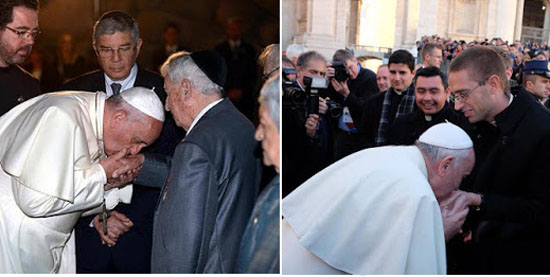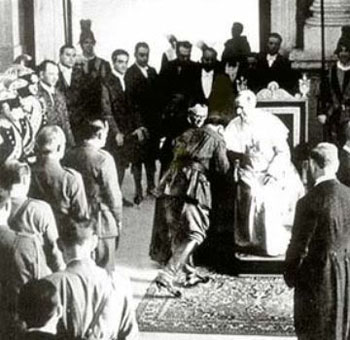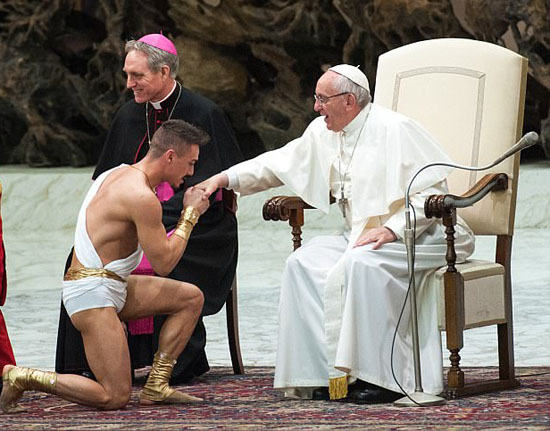Consequences of Vatican II
 |
 |
 |
 |
 |
 |
 |
New Papal Game:
Pull Back the Hand before It Is Kissed

Watch the video here
Smiling ironically, he turned his rejection of that gesture of respect into a new papal game. It would be as if he were saying: "Let's see how fast I can withdraw my hand and push the stupefied faithful on. Ha, ha! See how humble I am." He even went so far as to grab the right hand of one stubborn devotee who tried to kneel and pushed her up forcefully to send her on her way.
After numerous lightning-speed withdrawals – as a young Bishop and old friar with frozen fake smiles stood by observing – Francis finally found two young youth in casual navy crew shirts who greeted him as he likes: They took his hand and grasp it as equals. To these two he paused to give extra time. They appeared to be asking his blessing for some pictures and a rosary, to which he gave a two-thumbs-up response.
This new revolutionary game reveals, in my view, not only the egalitarian and vulgar spirit to which we have become accustomed. That cagey smile of glee as he draws back his hand reflects a great hatred for the pomp and power of the highest office of the Church that he holds, along with disdain for those who would still acknowledge it.
Rejection of papal authority
Every bishop receives a crosier, cross and episcopal ring at the time of his consecration. From the time of the Franks, the ring was worn as a sign of the episcopal honor and fidelity (signum pontificalis honoris and signaculum fidei). (1) A symbol of his office, it represents his fidelity and nuptial bond with the Church.

No problem for Francis to bow and kiss the hands of Jewish survivors of concentration camps or newly ordained progressivist priests, clearly below him in office and situation.
The ring of the Pope has a special significance since he holds the highest office in the Church and is invested with the supreme power. Thus, kissing the papal ring as a means of honoring a Pope as Sovereign Pontiff was normal protocol in the Papal Court. There was even a special court ceremonial termed the baciamano, where visitors to the Vatican lined up to greet the Pope and kiss the papal ring.
This custom has been on the decline since the pontificate of Paul VI, as the post-conciliar Popes have moved – steadily and deliberately – to wipe out the ceremonial and symbols in the Papacy. Since Vatican II, we have painfully watched the desacralization of our Holy Church, not only in the liturgy, but also in the ceremonies and customs.

Spanish generals at a baciamano paying their respect to Pope Pius XII
Both John Paul I and John Paul II dispensed with the coronation. The Gestatory Chair, the Canopy and the Flabelli were abandoned by John Paul II. Francis is finishing with the leftovers of this long process of auto-destruction. It is not exaggerated to say that the symbols of papal royalty have all been abandoned and relegated to museums.
The solemn and magnificent vehicles to transport the Vicar of Christ were replaced by the proletarian popemobile by Paul VI and John Paul II; Francis brought papal transportation to a new low by rejecting the luxury cars used before him and choosing to ride in the cheapest ones on the market – and even taking the bus. The papal majestic plural "we" in papal document has been gone since John Paul II, the solemn ceremonial vestments of Pontiffs are today gathering dust in closets or donated to museums.
It is useful to repeat that this process of the desacralization of the Church by destroying her ceremonial, pomp and rich symbols started shortly after Vatican II, a task of destruction taken up by all the post-conciliar Pontiffs.
But, none of them seems to have pursued the work of demolition with the passion and energy shown by Francis. His intent on smashing to dust every remnant of the beautiful symbols of papal authority goes as far as to making a perverse game of reviling the visitors who resurrect the good custom of kissing his miserablist episcopal ring...
I would say that what Pope Bergoglio wants is bury every symbol of papal authority.

Exception to the New Rule:
Francis, so adamant in refusing the baciamano from the respectable visitors at Loreto on the Feast of the Annunciation, earlier accepted the homage of a barely dressed circus acrobat
- Walter Ullmann, The Growth of Papal Government in the Middle Ages, London, 1962, p. 255.
- J.C. Noonan, The Church Visible: The Ceremonial Life and Protocol of the Roman Catholic Church, Sterling Pub., 2012, pp. 325-26
- Motu proprio decree Pontificalis Domus of March 28, 1968.

Posted March 27, 2019
______________________
______________________
 Volume I |
 Volume II |
 Volume III |
 Volume IV |
 Volume V |
 Volume VI |
 Volume VII |
 Volume VIII |
 Volume IX |
 Volume X |
 Volume XI |
 Special Edition |


